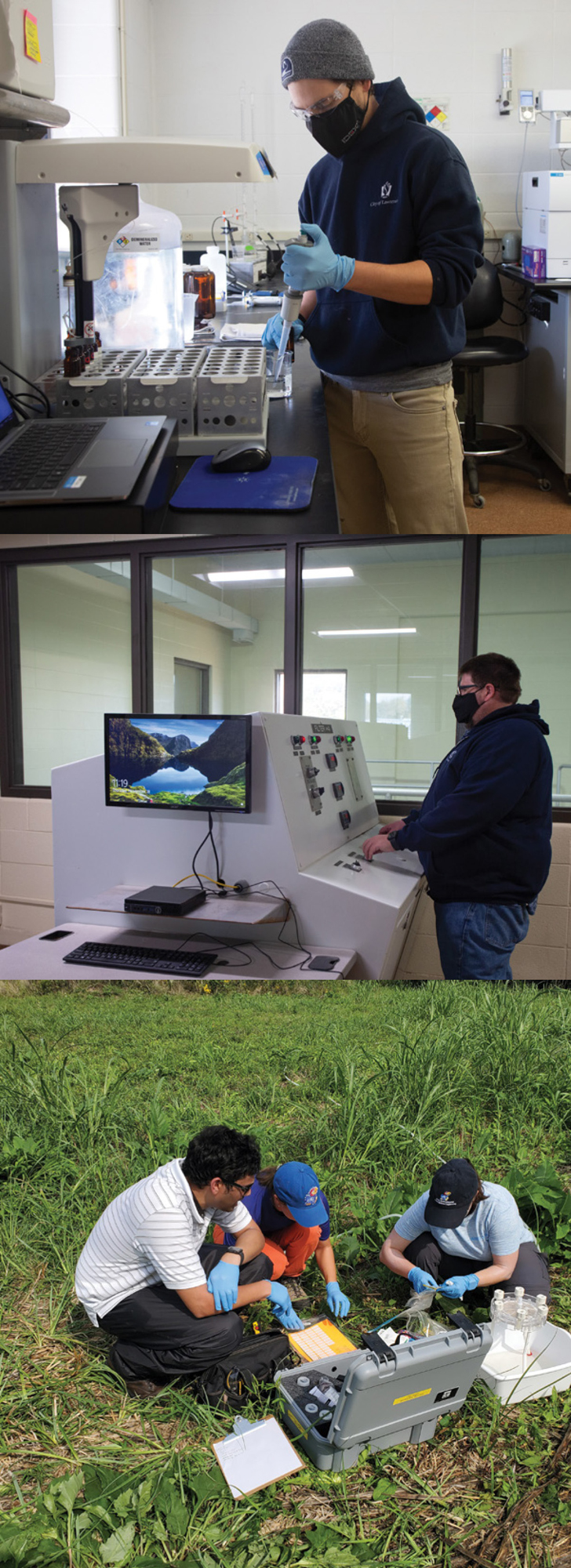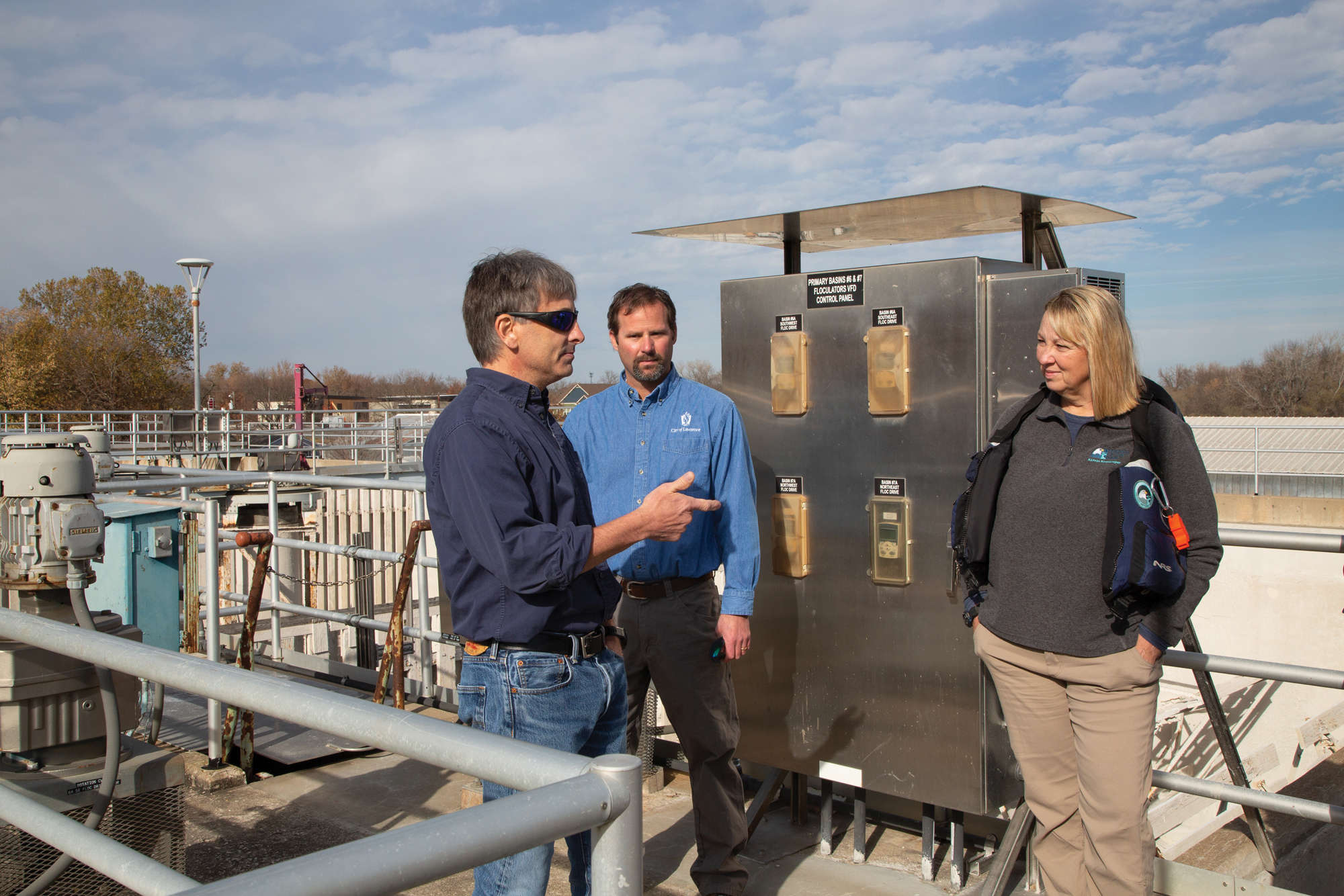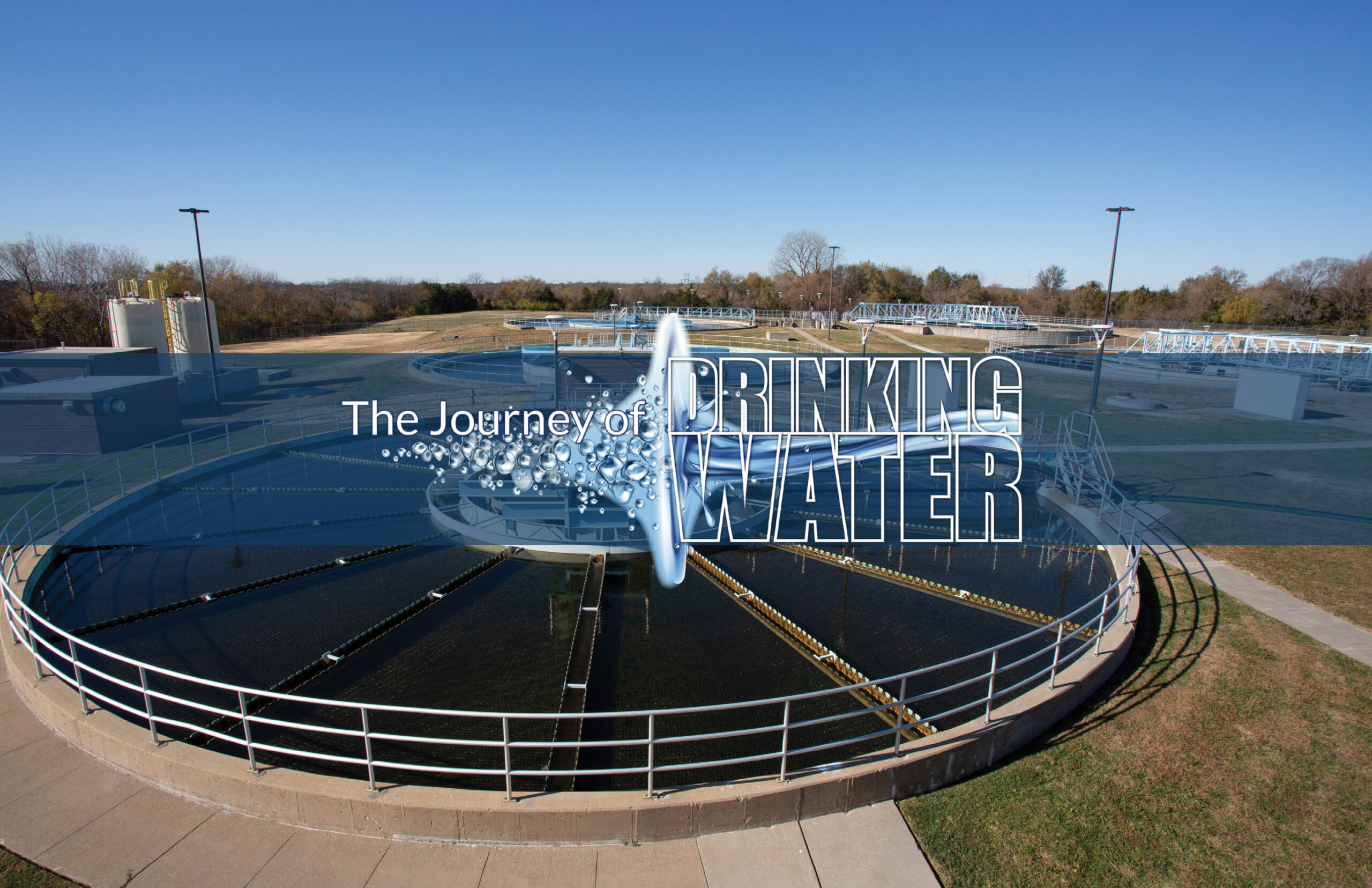| story by | |
| photos by | Steven Hertzog |
| OPEN A PDF OF THE ARTICLE |
Fighting an aging infrastructure, the City of Lawrence works to ensure residents, businesses and all other entities have clean, safe drinking water today and into the future.

Clinton Reservoir Water Treatment Plant
It’s something everybody does every day of their lives without giving it a second thought. They get out of bed in the morning, or even sometimes in the middle of the night, and walk straight to the nearest sink and faucet for a drink of water. Or guzzle out of a water fountain at a park during a workout or play day. Or wash their hands, shower, cook—any other numerous mindless daily activities.
Yet does anyone stop and take a moment to think about the journey water takes from the source to the tap? What types of processes it must endure to make it clean and suitable for drinking, cooking, bathing, etc.? Something so basic to our daily human existence is easily taken for granted, but the process is long, complex and, yes, even fascinating.
It’s something Mike Lawless, Trevor Flynn and Nic Caruthers think about incessantly each and every day. As members of Lawrence’s Municipal Services and Operations department, it’s their responsibility, along with 120 or so more employees, to ensure citizens of Lawrence and surrounding areas have a constant flow of clean, healthy and tasty drinking water.
It’s also something Lawless, Flynn and the team take great pride in.

Top to Bottom: Nick Martin, water quality lab technician tests water samples Steven Craig, operations manager at Clinton Reservoir Water Treatment Plant KU students taking samples to look at soil PFAS contamination Photo by Justin Hutchison
“We received the honor of having the best-tasting water in the state by the (Kansas Water Environment Association) and the (American Water Works Association),” says Flynn, assistant director of Lawrence’s Municipal Services and Operations. “We won best-tasting tap water in 2019 with a sample from the (Kaw River Water Treatment Plant).”
Lawrence is very fortunate to have not one but two water-treatment facilities, Flynn says. The city’s original Kaw River Water Treatment Plant, which opened in 1917 and is located on East Third Street, has a capacity to treat and move 16.5 million gallons of water per day, though on an average day, the volume runs around 5 million gallons (when it was built, the plant’s capacity was 3 million gallons). It sources its water from the Kansas River, just a stone’s throw to the north, as well as six alluvial wells. The newer Clinton Reservoir Water Treatment Plant, opened in 1980, has a capacity of 25 million gallons but treats an average of 7 million gallons a day. It draws water from Clinton Lake.
Between the two plants, 113,892 people are serviced through 570 miles of underground water main pipes. The City of Lawrence water system serves the population of Lawrence and wholesale customers of Baldwin City (which sells water to Edgerton and Wellsville), and Rural Water District Nos. 1, 2, 4, 5 and 6.
Lawless, the department’s deputy director, says average demand for a typical year is around 10 million gallons per day. During a peak day, which normally occurs during the hot, summer months when watering is most prevalent, demand doubles, to 20 to 22 million gallons. During peak hours, demand can increase three times, to 30 to 35 million. A city’s water system has to be able to account for those spikes, and Lawrence’s system appears to cover those bases well. That includes maintaining capacity in six storage towers throughout the area which, along with storage in clearwells and reservoirs at the treatment plants, have a total capacity between 10 and 11 million gallons.
“We do very well and are very fortunate to have two water facilities and two water sources,” Flynn says. “This builds tremendous resiliency in our operations and how we can reliably deliver high-quality drinking water to our customers.”
Lawless says, “Neither plant can supply a peak day or hour by itself. But either can supply an average day by itself.”
Lawless and Flynn are also quick to point out that contingencies are firmly in place in the instance of severe drought, the last of which occurred in 2012.
“We are a member of the Kansas River Water Assurance District No. 1 for drought contingencies,” Lawless explains. “It consists of 14 municipalities and industrial members. The district purchased storage in three federal reservoirs. If there is water in the storage, it is available for the district to call upon and use. It’s another resiliency piece.”
Whatever water needs, challenges or crises Lawrence residents and businesses might face in the future, it appears the City has all bases covered.

Kaw River Water Treatment Plant
From the Kaw to the Tap
The Kaw River Water Treatment Plant is a vast, complex labyrinth of pipes, pumps, basins and channels.
The journey water takes into the plant begins at the edge of the Kansas River, where five pumps work to move water into two intake pipes and up to the highest level of the facility. That way, gravity can be used to move the water through the long process to making it pure enough to drink.
Water from the Kaw is pumped up to a large presedimentation basin, which has a screen attached to a slow-churning arm. That screen separates large debris and sediment, which exits out the bottom of the basin and is sent back out to the river.
Turbidity is a scientific measurement of the cloudiness, or opaqueness, of a liquid, and tracking the NTU (nephelometric turbidity unit) count of the water as it moves through the purification process is a big part of what MSO plant operator Caruthers does daily.
“Water coming out of the Kansas River can range from 10 NTUs to about 2,000 when we have a lot of runoff flowing down the river,” he says.
From the presedimentation basin, water moves to a second basin where powder-activated carbon is added to remove odors.
“We use a lot more carbon at the Clinton facility to remove geosmin (an organic compound formed by bacteria), which causes undesirable taste and odor,” Caruthers says.
After carbon addition, the water goes to primary treatment. Lime is added to soften and reduce hardness. Alum and polymer are added to help form what is known in the water-treatment industry as floc (flocculation), the process in which colloidal particles come out of suspension and settle out for removal.
After that, it heads to secondary basins for stabilization and disinfection. Carbon dioxide is injected to lower the pH of the water to help stabilize. Sodium hypochlorite, more commonly known as industrial-strength bleach, is added, forming a free chlorine residual that is maintained across the basin. After secondary treatment and prior to filtration, more sodium hypochlorite, ammonia, phosphate and fluoride are added. The water then passes through anthracite coal, sand and gravel to further remove any particulate in the water.
Caruthers and other operators control everything from a control room with SCADA (Supervisory Control and Data Acquisition), a vast array of computers, screens and monitors that could be mistaken for a miniature version of mission control at NASA. From there, he and his team can keep an eye on the turbidity content, chlorine residual and other parameters as water moves through the system. He and the team make any adjustments necessary to get to the desired process parameters before the water moves into distribution pipes and is shipped off to homes, businesses and schools.
“If I see turbidity up, I can add polymer or carbon,” Caruthers says. “I can control mixing speeds. I can look at trends. I can see commercial use times and when they peak.”
Remember Caruthers claim that water moving into that first presedimentation basin can measure anywhere from 10 NTUs to 2,000? He proudly points to a monitor inside SCADA that shows the turbidity count of water by the time it reaches district pumps: 0.063 NTUs.
“Monday through Friday, we have two maintenance guys here throughout the day and on call,” he says. “We also have two guys in SCADA. We have at least one operator here 24/7.”

Mike Lawless (L) and Trevor Flynn on a tour of the Kaw River Water Treatment Plant with Dawn Buehler (R) from Friends of The Kaw
Regulations, Standards Changing
Justin Hutchison, an assistant professor in the Civil, Environmental and Architectural Engineering department at the University of Kansas and a member of the Bioengineering Core Faculty, has conducted research for the last several years looking at emerging biological and chemical threats when it comes to drinking water. More recently, he and his colleagues kicked off a project that will examine zeolite, a mineral used to treat contaminants in water, to treat what are known as PFAS (Per- and Polyfluoroalkyl Substances), a class of compounds capable of contaminating water.
The U.S. Environmental Protection Agency (EPA) has issued a health advisory pointing to two specific compounds—perfluorooctane sulfonic acid (PFOS) and perfluorooctanoic acid (PFOA)—that are of particular concern.
“As of now, we don’t know how many water systems are contaminated; we don’t know how widespread this is,” Hutchison says. “These contaminants are generally found in flame-retardant foams. They’re mostly found on military instillations. It’s still up in the air as far as how municipalities are affected.”
He points out that there haven’t been any new federal water regulations enacted in 20 years.
“I think the next block of new regulations will be on PFAS,” he says. “It’s definitely on the radar of municipalities.”
Other regulatory changes Hutchison sees coming have to do with changes in the Lead and Copper Rule (LCA), which are being discussed in terms of materials used in pipes.
Dealing with and adjusting to new regulatory requirements by the EPA is something MSO’s Flynn sees in the future for his department.
“What are we going to have to do to comply?” he asks.
MSO’s Lawless adds that the department has a good relationship with the rest of the Lawrence city government, and it’s maintained a progressive approach in moving forward with the city’s constantly increasing clean water needs. In all but one of his 14 years with the department, he says the city has passed incremental rate increases as opposed to holding steady for several years and then springing large increases on customers.
Much of the monies from those rate increases will go toward updating and improving an aging infrastructure of at least one facility that dates back more than a century and another that recently surpassed its 40th year of operation.
“Our infrastructure’s old,” Flynn says. “We have our share of pipe leaks. But, I think our emergency planning has really helped.”
Hutchison, for one, has faith that the City of Lawrence will do what it has to do to ensure that city residents, businesses and all other entities have clean and safe drinking water today, tomorrow and the days and years that follow.
“I think Lawrence has been very active and engaged in its responsibilities with regard to providing safe water,” he says. p
![]()





